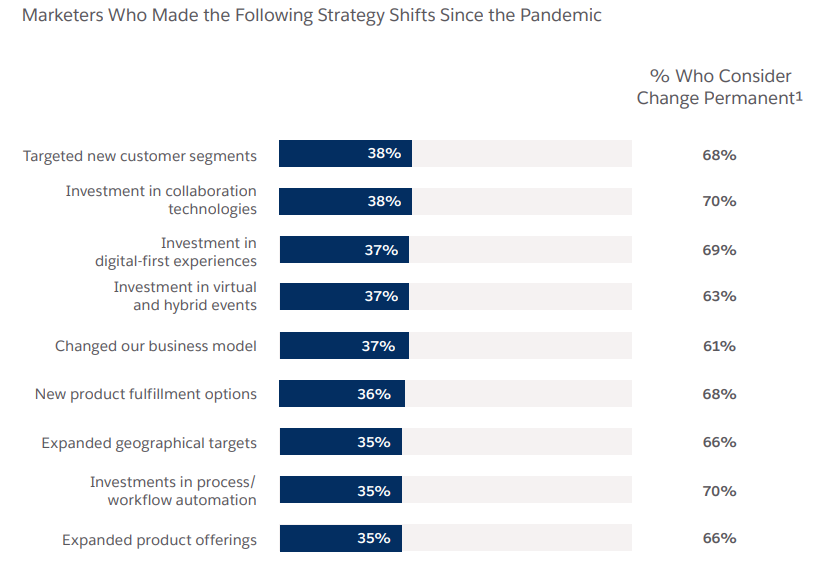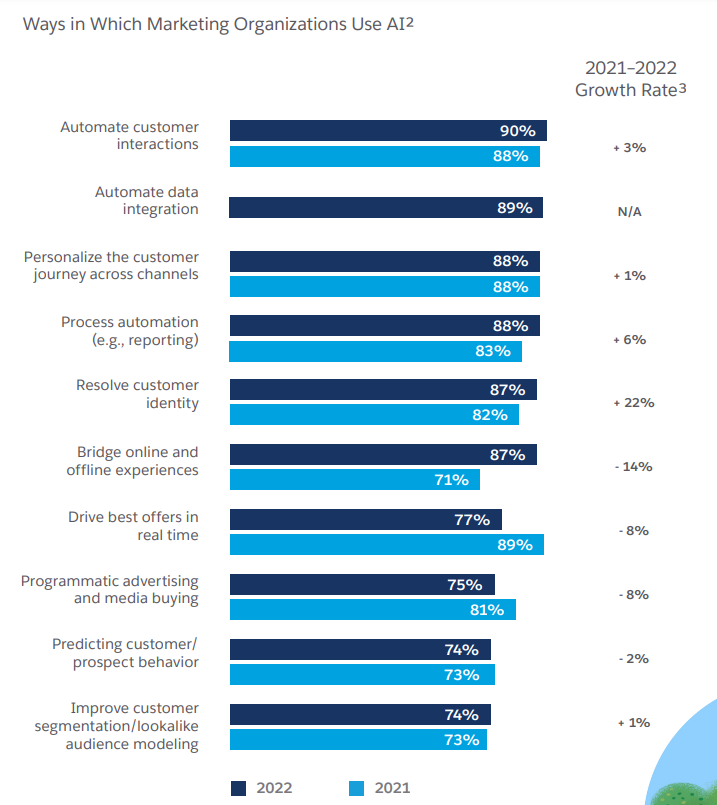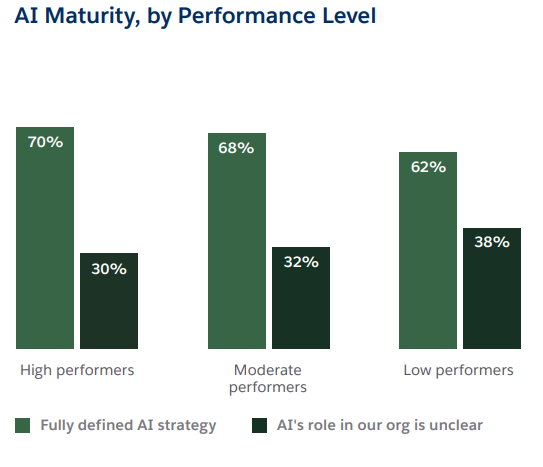 As a marketer, you are always looking for ways to stay ahead of the curve and stay one step ahead of your competition. The ever-changing landscape of marketing can be a challenge to keep up with, but it is important to stay on top of the latest trends and changes in the industry.
As a marketer, you are always looking for ways to stay ahead of the curve and stay one step ahead of your competition. The ever-changing landscape of marketing can be a challenge to keep up with, but it is important to stay on top of the latest trends and changes in the industry.
One of the biggest changes that are happening in the world of marketing is the way that consumers are interacting with brands. As the world changes, so do the challenges that businesses face. To stay ahead of the crowd, businesses must be constantly evolving to meet the ever-changing needs of their customers.
This week we decided to go through the Salesforce’s newest report “State of Marketing 8th edition”, check it and extract for you some of the most important trends we have noticed, and how they lead to the need for the implementation of an AI chatbot.
Here is what our team noticed:
87% of marketers say their work provides greater value now than it did a year ago – a 10 percent jump from last year. Why do you think is that? There could be many reasons, but what we think is that the growing power of technologies that ease our work and lives has contributed to our performance and motivation. These are mostly not new technologies. The growing adoption rate in the last few years, especially during and after the pandemic, has changed the way we work, and it is valid not only for marketers but in general for every profession. It includes usage of various technologies and tools for digitalization and for automation of work. One great example of such technology is the AI chatbot that helps businesses automate their customer service and support, improve marketing and sales processes, improve employee performance, and overall business further development.
88% of customers believe that trust becomes more important in times of change. What are the times of change? Well, every day something is changing (new business comes up, new technologies, new trends, new restrictions, etc.) and we as people and our businesses must adapt quickly to stay in the trends and be competitive. Brand trust and brand loyalty are more important than ever now when competition is so aggressive. Your business needs to think of ways to stand out from the crowd to earn customers’ loyalty and retain them for life. Answering customers’ questions 24/7, assisting them instantly – day or night, weekend, or holiday, and saving their time is one way to go. AI chatbots are performing very well in such tasks. Another way of doing this, especially when the biggest change in how customer data will be collected with Google’s restrictions over third-party cookies, is to use first and zero-party data collection tools (chatbots with conversational AI, email platforms, CRM systems, and others) to continue understanding your customers’ preferences and needs to gain their trust in you.
With the end of third-party cookies on the horizon, 68% of marketers have already a fully defined strategy to shift toward first-party data, and 54% already creating a first-party data strategy to prepare for the cookieless world. It is recommended to use not one but a few methods/tools for first and zero-party data collection working together for the best customer experience. For example, an AI chatbot can be a first and zero-party data collection tool on your website to engage and communicate with customers 24/7/365, collect their emails in exchange for something to download or get a special offer. Then your team can send more targeted email campaigns and start nurturing your customers in a personalized manner using CRM software. Start preparing for the third-party cookies’ disappearance now to be one step ahead of those who are waiting till the last moment. Chief Marketing Officers (CMOs) are specifically focused on building and retaining trust with customers (including keeping their data safe) which are in their top 3 priorities this year along with continuous innovation in technologies and tools and experimenting with new marketing strategies and tactics for overall business development. Other priorities they also have are balancing on personalization with customer comfort levels, improving the use and acceptance of tools and technologies, and improving collaboration between the business, its customers, partners, and employees.
Along with the top priorities, come the challenges, which are mostly the same that marketers and other businesses face and there is always a solution. According to the Salesforce report, marketers’ top challenges this year are:
– Ineffective use of tools and technologies
– Measuring marketing ROI and attribution
– Balancing personalization with customer comfort levels
– Building and retaining trust with customers
– Resistance to new marketing strategies and tactics
How to overcome these challenges by preparing for the changes and new trends? 91% of CMOs say they must continually innovate to remain competitive – fast acceptance of new technologies and marketing strategies to stand out from the crowd. For example, chatbots with conversational AI can help with a more innovative way of launching marketing campaigns, and selling products and services by creating marketing and sales funnels, also building strong relationships, and improving them with not only customers but with partners and employees by providing easy access to important information with self-service options for better collaborations 24/7.
Another challenge is that 71% of marketers say it’s harder to retain employees than it was a year ago. Why is that happening? As customers stick to businesses that offer more digital services, so the employees also prefer businesses that are more digital and technology-oriented, because they are customers too (to the company they are working for or other brands). They also want to be part of a company that takes care of their mental and physical health, keep them motivated, and provides opportunities for professional growth. AI chatbots and other digital services come to help. Someone will ask how AI chatbots help with the mental and physical health of employees and their motivation and we are ready with the answers here. A company that takes care not only of its customers but of its employees is more likely to be chosen by professionals which eventually will lead to further growth.
 The top new strategies that marketers consider making a shift to, according to the Salesforce report, are:
The top new strategies that marketers consider making a shift to, according to the Salesforce report, are:
– how they will target new customers segments,
– investment in digital-first experience,
– expanding in geographical targets,
– investment in workflow automation
Well, an AI chatbot could help with all of them. It can be shared online and offline from anywhere via a direct link or a QR code to assist customers whenever they search for assistance and wherever they are (online or at an offline store, or elsewhere) instantly. It can also be trained to assist in many languages many customers at once which will help employees focus on more complex tasks one customer at a time improving the quality of the assistance. Moreover, the chatbot automatically collects live statistics about customer behavior and needs that would help the business to predict trends and know its customers better, discover new target groups and address their interests and needs, to be able to offer more personalized and targeted campaigns. It is not a surprise that many businesses – of any size and industry, are sticking successfully to a business strategy that includes the usage of an AI chatbot on their site.
70% of marketers who made investments in their process/ workflow automation view this as a long-term strategy shift, underscoring the importance of boosting productivity and efficiency. We cannot help but share how AI chatbots can help with that. There are simple tasks that can be automated with an AI chatbot that can save the time of the employees for more complex duties. Customers could be directed to it for answers to frequently asked questions, forms, and information sections in the chatbot from social media accounts or other places. It is a known fact that up to 80% of the communication of the business is routine questions and inquiries. Automating the routine by using a chatbot can ease the workflow processes of customer service and support.
 In the face of demand for data-driven, personalized, and scalable customer experiences, 62% of marketers say they’ve invested in the power of artificial intelligence (AI). Wow! Well, AI does not include only chatbots but the fact that more and more people (especially in businesses) trust artificial intelligence is a breakthrough. The chatbot market and conversational AI market are growing every year, so we know that they are part of the worldwide trend. Here are some great numbers to prove that: the chatbot market will reach USD 3.99 billion by 2030. The market is expected to expand at a CAGR of 25.7% from 2022 to 2030. The global AI-enabled chatbots market would reach USD $8 Billion by 2026 (triple from 2022). 43% of the companies prefer chatbots integrated directly on their websites (not through messengers) as they facilitate enterprises in providing instant customer interaction and do not depend on messengers’ rules and policies. Chatbots find various applications in the e-commerce, healthcare, and BFSI sectors. Large enterprises emerged as the largest end-user segment in 2021 with over 50.0% share. The bots for the marketing application segment are expected to register the fastest growth rate during the forecast period as these chatbots can connect the customers directly to service providers being part of the company’s digital marketing funnels according to Research and Markets. Chatbot use cases vary from company to company and from industry to industry, and there are plenty of case studies proving their success (you can check a few case studies here), so we are wondering if you are already considering one for your business.
In the face of demand for data-driven, personalized, and scalable customer experiences, 62% of marketers say they’ve invested in the power of artificial intelligence (AI). Wow! Well, AI does not include only chatbots but the fact that more and more people (especially in businesses) trust artificial intelligence is a breakthrough. The chatbot market and conversational AI market are growing every year, so we know that they are part of the worldwide trend. Here are some great numbers to prove that: the chatbot market will reach USD 3.99 billion by 2030. The market is expected to expand at a CAGR of 25.7% from 2022 to 2030. The global AI-enabled chatbots market would reach USD $8 Billion by 2026 (triple from 2022). 43% of the companies prefer chatbots integrated directly on their websites (not through messengers) as they facilitate enterprises in providing instant customer interaction and do not depend on messengers’ rules and policies. Chatbots find various applications in the e-commerce, healthcare, and BFSI sectors. Large enterprises emerged as the largest end-user segment in 2021 with over 50.0% share. The bots for the marketing application segment are expected to register the fastest growth rate during the forecast period as these chatbots can connect the customers directly to service providers being part of the company’s digital marketing funnels according to Research and Markets. Chatbot use cases vary from company to company and from industry to industry, and there are plenty of case studies proving their success (you can check a few case studies here), so we are wondering if you are already considering one for your business.
 68% of marketers say they have a fully defined AI strategy, up from 60% in 2021 and 57% in 2020 which is a more than 10% growth for just 2 years in embracing the need of improving customer experience and automating customer interactions for faster and effective results with the help of some sort of AI applications, in which AI chatbots are part of. AI chatbots help with instant support in real-time to resolve customer issues and needs or to engage for marketing and sales purposes for the “next best offer in real time”. Which are the top identified ways marketers use AI in the business strategy? Artificial Intelligence is used for:
68% of marketers say they have a fully defined AI strategy, up from 60% in 2021 and 57% in 2020 which is a more than 10% growth for just 2 years in embracing the need of improving customer experience and automating customer interactions for faster and effective results with the help of some sort of AI applications, in which AI chatbots are part of. AI chatbots help with instant support in real-time to resolve customer issues and needs or to engage for marketing and sales purposes for the “next best offer in real time”. Which are the top identified ways marketers use AI in the business strategy? Artificial Intelligence is used for:
- automation of customer interactions by 90% of the surveyed in the report with a 3% growth by last year,
- personalization of the customer journey across the different channels,
- bridging online and offline experiences,
- predicting customer behavior,
- driving best offers in real-time and
- improving customer segmentation.
All these ways of using AI applications, especially AI chatbots could help to scale up your business, prepare for the constantly changing trends and be a hundred steps ahead of the growing competition. Marketers already are using such tools, what about your business? The time to start is now if you want to have a fully working AI digital employee by your side on your website in just a few months! You can try out our platform with a 14-day free trial period to give a start on your chatbot journey.
 An interesting fact when talking about the speed of digitalization and the need for a digital-first experience: according to the Salesforce report, 43% of customers say they prefer non-digital channels which leads to the need for a balanced online and offline communication strategy for meeting all customers’ needs. Here comes the need for not only providing digital channels for communication but also offline ones, and a connection between them for a smooth transition from offline to online. An AI chatbot perfectly handles such a transition. It is available online 24/7 and accessible on the business site for instant support and accessible by a direct link and by a QR code from anywhere. For example, direct access to it by a QR code placed somewhere in your offline store or other property for immediate assistance – on your products, business cards, flyers, keychains, etc. One great example is how hotel complex Izgreva placed a QR code to their hotel AI chatbot on the keychains of the rooms’ keys and the guest can access it anywhere they are to ask a question when the employees are busy or are resting during the night. This a great example of a balanced online and offline business strategy for success!
An interesting fact when talking about the speed of digitalization and the need for a digital-first experience: according to the Salesforce report, 43% of customers say they prefer non-digital channels which leads to the need for a balanced online and offline communication strategy for meeting all customers’ needs. Here comes the need for not only providing digital channels for communication but also offline ones, and a connection between them for a smooth transition from offline to online. An AI chatbot perfectly handles such a transition. It is available online 24/7 and accessible on the business site for instant support and accessible by a direct link and by a QR code from anywhere. For example, direct access to it by a QR code placed somewhere in your offline store or other property for immediate assistance – on your products, business cards, flyers, keychains, etc. One great example is how hotel complex Izgreva placed a QR code to their hotel AI chatbot on the keychains of the rooms’ keys and the guest can access it anywhere they are to ask a question when the employees are busy or are resting during the night. This a great example of a balanced online and offline business strategy for success!
71% of marketers say that meeting customer expectations is more difficult than a year ago and at the same time, 73% of customers expect companies to understand their unique needs and expectations. Customers want the best experience when it comes to buying from a certain brand, not only the product or the service but the support before and after their purchase, to feel special that the brand they are going to buy from is taking care of them and their true needs. That is not an easy thing to do. Companies shall have many ways for understanding customers’ true problems and needs with the protection of personal data and space. 82% of high-performing marketers say customer experience is a key competitive differentiator and feel confident that they’re getting closer to cracking the code. As we already mentioned above, a chatbot with conversational AI on the website can act as a first and zero-party data and conversational data collection tool for understanding customer behavior – where customers are, at what time of the day, what they are looking for, and their willingness to share an email or mobile phone in exchange to receive something useful for them from the brand. Both sides win – the business got customers’ emails for more personalized campaigns and customers got an e-book, a report, a discount, or something else and answers to their questions all done by the AI chatbot, available 24/7 for customer interactions and better user experience.
In addition to customer data, marketers need to track now more KPIs than ever before – customer satisfaction metrics, content engagement, customer retention rates, etc. for better personalization and customer touchpoints. Statistics and data that the AI chatbot collects in real-time about customer behavior and interests would assist in further analysis and higher performance of marketing campaigns.
83% of marketers say their marketing organizations engage customers in real-time across one or more marketing channels for the best user experience. By implementing an AI chatbot on the website and using the custom links and QR codes that open precise page of the site with a concrete element in the chatbot – information, form, or else, the business can guide the customers with 1 click or scan from posts in social media accounts and other channels to the digital center of the business – the website.
One of the top marketing tactics currently in use with a higher growth rate according to the Salesforce report is the creation of interactive content with a 37% increase from 2021 to this year. An AI chatbot on your site, for sure is an interactive tool that engages users in real-time which helps with the two-way communication business-customers. The AI chatbot can guide them to fill out a form to receive something, to have a casual chat, or redirect them to more useful information or something to download for later use. It can be as interactive as the business creates it to meet its goals and needs.
69% of marketers say it’s harder to collaborate now than before the pandemic and that’s why 45% of marketers are using instant messaging or chat apps for collaboration – not just one channel for communication for the comfort of customers, partners, and employees all over the world. Businesses must choose wisely which one will suit them when it comes to internal or external communication. Here are some of the pros and cons of most of the communication channels to choose the best for your company (just a tip: choose not one but two or three to work together in the favor of your business).
In the end let’s not forget that to stay in the game and win it, marketers are seeking constantly to uplevel their skills. According to the report, the focus is on skills like:
– improving content marketing,
– campaign strategies,
– creativity,
– data analytics and
– communication.
Well, the solution is before your eyes – by deciding to implement an AI chatbot on your site, planning the whole project, launching it, using it proactively, and growing it further, as a marketer this will help practice and further develop all of these 5 skills – planning and creating the content, the strategy of launching and promoting it, using creativity to make the chatbot as interactive as technologically possible as well as useful, to have them work in favor of the business, its customers, partners, and employees. Deciding what customer data will be collected, and how to use it safely for better user experience and successful campaigns as well as analyzing it would also help with the development of marketers’ skills.
Finally, the way how the chatbot will be trained to communicate with the customers and to smoothly direct to employees when a human is needed and all these processes of communication automation between the different channels would help to strengthen the relationship between the business, its customers, and employees. The long-term work for the chatbot project would help marketers to uplevel their skills and develop new ones. You can check out our complete guide for chatbot project to learn the best practices and what to avoid before starting a such business project to lead it to success.
If you want to be part of the never-ending development of the digital world, try out new technologies and strategies, such as AI chatbot on your site, for overall business growth and better user experience. Contact us for a free consultation for your business and do not miss to follow our LinkedIn account for weekly trends, ideas, and tips!
Sources:
-Salesforce – State of Marketing 8th edition
-State of the Connected Customer,” Salesforce, May 2022